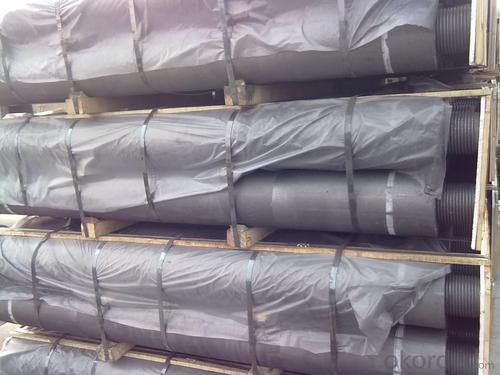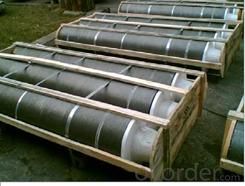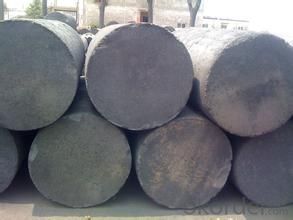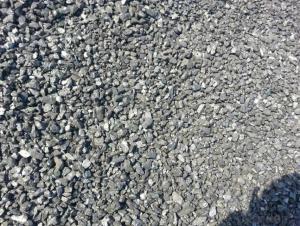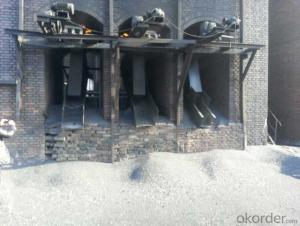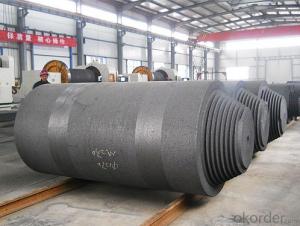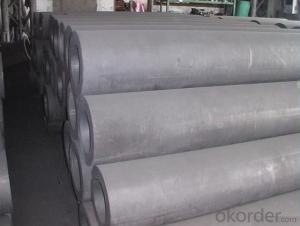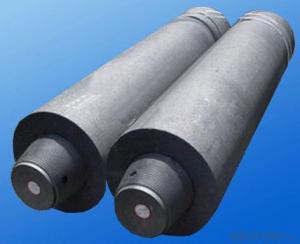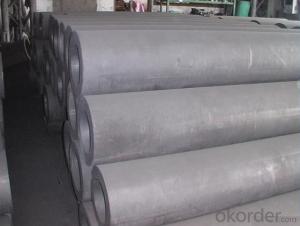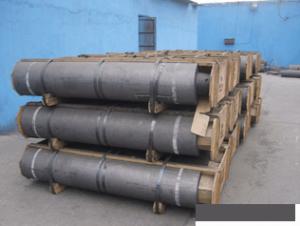Carbon Electrode Φ750~Φ960 G Grade With Good Qulity
- Loading Port:
- Tianjin
- Payment Terms:
- TT or LC
- Min Order Qty:
- 20 m.t.
- Supply Capability:
- 800 m.t./month
OKorder Service Pledge
OKorder Financial Service
You Might Also Like
Product Description
Carbon Electrode is abaked electrode used in submerged arc furnaces for delivering power to the charge mix. Electrode is added to the top of the electrode column cylindrical form. Electrode is essentially a mix of Electrically Calcined Anthracite (ECA) or Calcined Petroleum Coke (CPC) with Coal Tar Pitch and is baked for weeks, it is widly used for ferroally productiong, silicon metal production etc.
Carbon Electrode General Specification:
PARAMETER UNIT GUARANTEE VALUE | ||||||
Ash.( % ) | 4.0 max | 5.0 max | 6.0 max | 7.0 max | 9.0 max | 11.0 max |
V.M (%) | 12.0-15.5 | 12.0-15.5 | 12.0-15.5 | 9.5-13.5 | 11.5-15.5 | 11.5-15.5 |
Compress Strength. (Mpa) | 18.0 min | 17 min | 15.7 min | 19.6 min | 19.6 min | 19.6 min |
Specific Resistance (μΩm) | 65 max | 68 max | 75 max | 80 max | 90 max | 90 max |
Bulk Density (G/CM3) | 1.38 min | 1.38 min | 1.38 min | 1.38 min | 1.38 min | 1.38 min |
Package: in pallets
Picture:
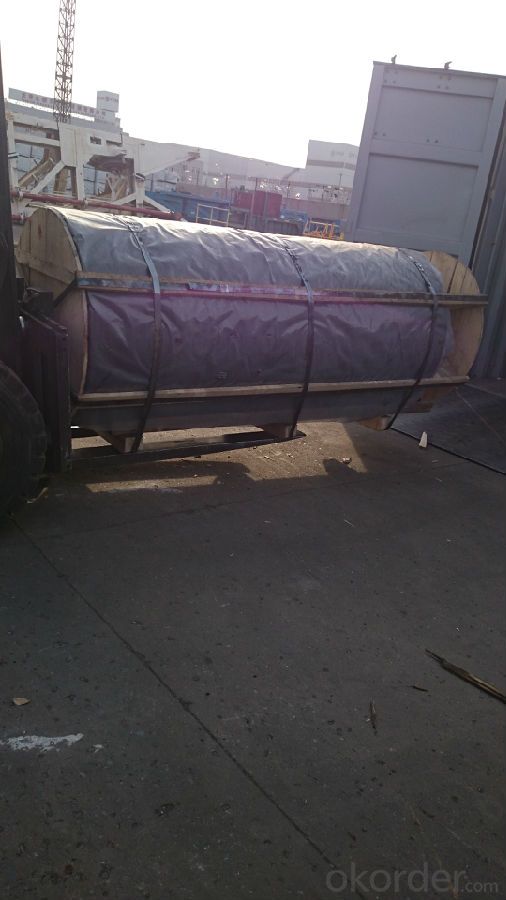
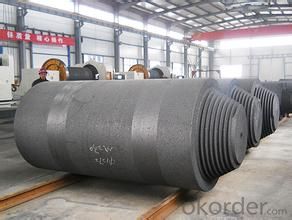
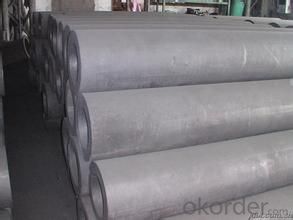
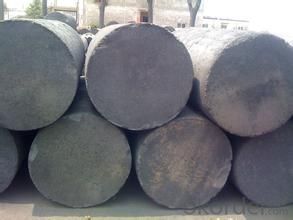
We Also supply all kind of carbon electrode paste and below materials, please contact us if you have any enquiry about it.
Calcined Anthracite
Calcined Petroleum Coke
Coke (Met Coke, Foundry Coke, Semi Coke)
- Q: What are the consequences of increased carbon emissions on technological advancements?
- The consequences of increased carbon emissions on technological advancements can be significant. The primary consequence is the acceleration of climate change, which can lead to adverse effects such as rising global temperatures, sea-level rise, extreme weather events, and ecosystem disruptions. These consequences pose various challenges to technological advancements. On one hand, they create a pressing need for innovative solutions to mitigate and adapt to climate change, such as renewable energy sources, carbon capture and storage technologies, and sustainable agricultural practices. This can drive research and development in these areas, fostering technological advancements. On the other hand, increased carbon emissions can also divert resources and attention away from other technological advancements, as efforts are redirected towards climate change mitigation and adaptation strategies. Additionally, the consequences of climate change, such as natural disasters or resource scarcity, can disrupt technological infrastructure and impede further advancements. Therefore, while there can be opportunities for technological advancements in response to increased carbon emissions, the overall consequences can also present challenges and limitations.
- Q: Power plant water treatment plant, there is a carbon removal device, the expert pointing out what the principle is it?
- The water enters from the upper part of the carbon removing device and is poured down by the water distribution equipment and enters the water tank from the lower part through the filling layer. In addition to carbon, due to the blocking effect of filler, flow down from the top of the water is dispersed into many small stocks or drop, from the bottom of the drum into the air and water contact area is very large, and the partial pressure of carbon dioxide in the air is very low, so it will come out from the water desorption carbon dioxide quickly away. Water can be removed by blowing carbon, which can reduce the carbon dioxide content to below 5mg/L. In fact, the simple point is that the amount of dissolved gas in water is proportional to the pressure of the air he touches. This principle is similar to the principle of the atmospheric Deaerator in the power plant. I hope I can help you
- Q: How many points can Yongan change for 1 carbon coins?
- Every Thursday at 19:00, carbon points change for carbon coins, 19:30 carbon coins exchange gifts
- Q: How does carbon affect the formation of acidification in lakes?
- Carbon dioxide (CO2) plays a significant role in the formation of acidification in lakes. When carbon dioxide is released into the atmosphere through various human activities, such as burning fossil fuels, it can be absorbed by water bodies like lakes. This absorption leads to the formation of carbonic acid (H2CO3), a weak acid. Carbonic acid dissociates into hydrogen ions (H+) and bicarbonate ions (HCO3-) in water. The increase in hydrogen ions causes a decrease in pH levels, making the water more acidic. This process is known as acidification. Acidification in lakes can have detrimental effects on aquatic ecosystems. It affects the physiology and behavior of many species, including fish, amphibians, and invertebrates. Acidic waters can also damage the eggs and larvae of these organisms, hindering their growth and survival. Additionally, acidification can alter the composition and abundance of phytoplankton, which are crucial for the overall health of the ecosystem. High levels of acidity can also lead to the leaching of toxic metals, such as aluminum, from the surrounding soil and rocks. These toxic metals are then dissolved in the water, posing an additional threat to aquatic organisms. Acidification can also disrupt the nutrient cycles in lakes, affecting the availability of essential nutrients for plants and animals. In summary, the presence of carbon dioxide in the atmosphere contributes to the acidification of lakes when it is absorbed by water. This acidification has a range of negative impacts on the aquatic ecosystem, including altered physiology, impaired reproduction, and disrupted nutrient cycles. It is crucial to reduce carbon emissions and mitigate the effects of acidification to protect the health and diversity of lake ecosystems.
- Q: How is carbon used in the production of filters?
- Due to its unique properties, carbon finds common usage in filter production. One of the primary applications of carbon in filters is its capacity to adsorb impurities and contaminants, attracting and retaining them. This is attributed to carbon's extensive surface area and multitude of minute pores, enabling it to effectively capture and eliminate particles, chemicals, and odors from substances like air, water, and more. In air filters, carbon is frequently combined with other materials, such as activated charcoal, to form activated carbon filters. These filters are utilized to eradicate air pollutants, allergens, and odors. The activated carbon adsorbs the contaminants, entrapping them within its porous structure and ultimately enhancing the overall air quality. In water filters, carbon can be employed in diverse forms, like granular activated carbon (GAC) or carbon block filters. GAC filters are widely utilized in household water filtration systems and are adept at eliminating chlorine, volatile organic compounds (VOCs), pesticides, and other chemicals. Conversely, carbon block filters are produced by compressing activated carbon into a solid block, thus providing a greater surface area and superior filtration efficiency. Apart from air and water filters, carbon is also utilized in various other filter types, such as those utilized in industrial processes, gas masks, and respirators. The versatility of carbon in filtering applications stems from its capability to adsorb a broad range of contaminants and its high adsorption capacity. Its inclusion in filters aids in enhancing the quality and safety of the substances undergoing filtration, rendering it an indispensable material in numerous filtration processes.
- Q: How do plants and trees absorb carbon dioxide?
- Plants and trees absorb carbon dioxide through a process called photosynthesis. Photosynthesis is the process by which plants convert sunlight, water, and carbon dioxide into glucose (sugar) and oxygen. The process takes place in the chloroplasts, which are specialized structures within the plant cells. During photosynthesis, plants absorb carbon dioxide from the atmosphere through tiny pores on their leaves called stomata. The carbon dioxide enters the plant's cells and travels to the chloroplasts. Inside the chloroplasts, energy from sunlight is used to convert the carbon dioxide and water into glucose and oxygen. The glucose produced through photosynthesis is used by the plant as a source of energy for growth, reproduction, and other metabolic activities. Some of the glucose is stored in the plant as starch, while the rest is used to produce other essential compounds. The oxygen produced during photosynthesis is released back into the atmosphere through the stomata. This oxygen is vital for the survival of animals, including humans, as it is necessary for respiration. Overall, plants and trees play a crucial role in absorbing carbon dioxide from the atmosphere through photosynthesis. They act as natural carbon sinks, helping to regulate the levels of this greenhouse gas and mitigate the effects of climate change.
- Q: Why is the longer the carbon chain, the better the hydrophobic properties?
- Alkyl chains, low in polarity, insoluble in water...... Release53 (TA station) of all alkanes alkane chain containing even chemical bonds are sigma bond, charge distribution in the molecule is not very uniform, the movement process can produce instantaneous dipole moment, but the total dipole moment is zero, non polar molecules. According to the similarity principle of compatibility, alkane in general can only be dissolved in carbon tetrachloride, like hydrocarbons and other non polar solvent, so the more you long alkane chain, as hydrophobic groups, then you must material hydrophobicity and better advice and look at textbooks still need some basic theory of organic.
- Q: What are the impacts of carbon emissions on the stability of permafrost?
- Carbon emissions have a significant impact on the stability of permafrost. Permafrost refers to the layer of soil, sediment, and rock that remains frozen for at least two consecutive years. It covers vast areas in the Arctic, subarctic regions, and high-altitude mountain ranges. One of the main impacts of carbon emissions on permafrost stability is the acceleration of climate change. Carbon dioxide (CO2) and other greenhouse gases trap heat in the atmosphere, leading to global warming. As temperatures rise, permafrost starts to thaw, causing a range of negative consequences. Thawing permafrost releases large amounts of stored carbon into the atmosphere. This carbon was previously locked in the frozen organic matter, such as dead plants and animals, which accumulated over thousands of years. As permafrost thaws, microbes decompose this organic matter and release greenhouse gases like carbon dioxide and methane. These emissions create a positive feedback loop, further exacerbating climate change and leading to more permafrost thawing. The release of carbon from thawing permafrost contributes to the overall increase in atmospheric greenhouse gas concentrations. This, in turn, amplifies global warming and global climate change. The impacts are not limited to the Arctic; they affect the entire planet. Rising temperatures, sea-level rise, extreme weather events, and disruptions to ecosystems are some of the consequences of global climate change. Permafrost thaw also affects infrastructure and human settlements in the Arctic and subarctic regions. Buildings, roads, pipelines, and other infrastructure built on permafrost can be destabilized as the ground beneath them softens. This can lead to structural damage and economic losses. Additionally, communities that rely on permafrost for traditional activities such as hunting, fishing, and transportation face challenges as the landscape changes. The impacts of carbon emissions on permafrost stability are not only local but also global. The release of stored carbon from permafrost contributes to climate change, which has far-reaching consequences for ecosystems, economies, and societies worldwide. It is crucial to reduce carbon emissions and mitigate climate change to preserve permafrost and its vital role in the Earth's climate system.
- Q: What's the difference between carbon steel pipes and stainless steel pipes and seamless steel tubes?
- As the name implies, carbon steel is made of carbon steel, forming mostly by welding, drawing, rolling, adopted the extrusion molding, and the steel tube drawing, rolling, extrusion molding are called seamless steel pipe welded steel pipe.
- Q: What is the boiling point of carbon?
- The boiling point of carbon, an element that is not metallic, is determined by its allotrope. Carbon exhibits various allotropes, such as graphite and diamond, each possessing distinct physical characteristics. Graphite, comprising layers of carbon atoms organized in a hexagonal lattice, lacks a boiling point because it directly transitions from a solid to a gas through sublimation. Conversely, diamond, composed of carbon atoms arranged in a three-dimensional lattice, also lacks a boiling point as it undergoes direct sublimation. Consequently, carbon, in its pure elemental form, does not possess a boiling point.
Send your message to us
Carbon Electrode Φ750~Φ960 G Grade With Good Qulity
- Loading Port:
- Tianjin
- Payment Terms:
- TT or LC
- Min Order Qty:
- 20 m.t.
- Supply Capability:
- 800 m.t./month
OKorder Service Pledge
OKorder Financial Service
Similar products
Hot products
Hot Searches



